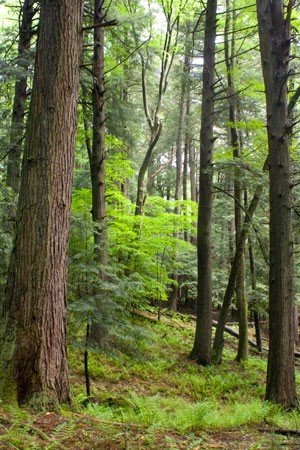
Cook Forest: Pennsylvania’s “First Natural Park”
Cook Forest State Park is known as one of the last remaining stands of old growth hemlock in the eastern United States. This unique biome is a remnant of what Pennsylvania looked like before meeting the axes of European-Americans.
For over two centuries the Cook family owned and utilized these wide tracts of timber within the Clarion River watershed. Following the death of Andrew Cook in 1891, his heirs formed the A. Cook Company to continue the family lumber business. After two generations of logging and milling it was realized that much of the majestic forest which sustained both Cook family and Pittsburgh’s industrialism, had been depleted.
Anthony Wayne Cook, one of the primary heirs of the Cook family lands, met with the outspoken and successful M. Israel McCreight in August of 1910. McCreight was a well-known businessman as well as having been an advocate for conservation of historical and natural landmarks. He expressed his passion to Mr. A.W. Cook while strolling through the “silent cathedral” of the forest.¹ “Cook, no greater crime could be committed than to destroy this; it shall not be destroyed; it must be saved for humanity’s sake.”² The gentleman then recommended to Cook that the newly founded Pennsylvania Conservation Association would be able to assist in preserving the rest of his family’s old growth forest.
Many famous forest conservation advocates of Pennsylvania supported the idea of a Cook Forest park. Agriculturalist and inventor Arthur Farquhar, President of the American Civic Association J. Horace McFarland, Chief of the United States Forest Service Gifford Pinchot, and Commissioner of the Pennsylvania Department of Forests and Waters Joseph Rothrock all supported the preservation of Cook’s forest. These early leaders of Pennsylvania’s environmental movement bolstered public support by raising awareness regarding the proposed idea converting Cook’s forest into a national natural heritage site.
The Cook Forest Association was established in 1923 to take donations and encourage financial contributions to save the last stands of ancient trees in Cook Forest from being milled. The state legislature approved a budget of $450,000 to purchase the forest from the Cook family under the condition that the Cook Forest Association would be able to raise an additional $200,000 to purchase the property. In 1927 the Association was able to raise the necessary funds and finally in 1928 the Pennsylvania Assembly created the Cook Forest Park as the Keystone State’s “first natural park.”³
Visit the DCNR website for additional information on Cook Forest State Park.
__________
¹ Israel McCreight, Cook Forest Park: Story of the Sixteen Year Battle to Save the Last Stand of Historic Penn’s Woods. The When, The Why, and How of it. 1936.
² Ibid.
³ Mary Byrd Davis, Eastern Old-Growth Forests: Prospects for Rediscovery and Recovery (Island Press: April 1996) p. 286.
